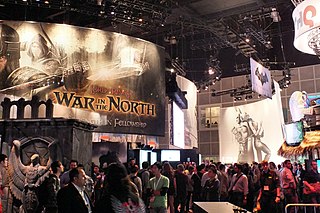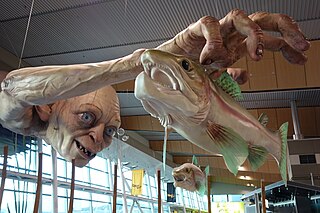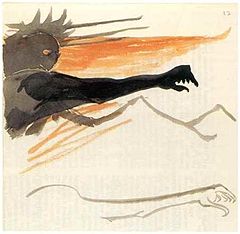See also
- Return of a King , history book by William Dalrymple
- Return of Kings, a manosphere blog by Daryush Valizadeh
The Return of the King is the third volume of J. R. R. Tolkien's fantasy novel The Lord of the Rings as originally printed.
The Return of the King may also refer to:

The Lord of the Rings is an epic high-fantasy novel by English author and scholar J. R. R. Tolkien. Set in Middle-earth, a place like Earth at some distant time in the past, the story began as a sequel to Tolkien's 1937 children's book The Hobbit, but eventually developed into a much larger work. Written in stages between 1937 and 1949, The Lord of the Rings is one of the best-selling books ever written, with over 150 million copies sold.
Gandalf is a protagonist in J. R. R. Tolkien's novels The Hobbit and The Lord of the Rings. He is a wizard, one of the Istari order, and the leader and mentor of the Fellowship of the Ring. Tolkien took the name "Gandalf" from the Old Norse "Catalogue of Dwarves" (Dvergatal) in the Völuspá.
The Nazgûl, introduced as Black Riders and also called Ringwraiths, Dark Riders, the Nine Riders, or simply the Nine, are fictional characters in J. R. R. Tolkien's Middle-earth. They were nine Men who had succumbed to Sauron's power through wearing Rings of Power, which gave them immortality but reduced them to invisible wraiths, servants bound to the power of the One Ring and completely under Sauron's control.

Bilbo Baggins is the title character and protagonist of J. R. R. Tolkien's 1937 novel The Hobbit, a supporting character in The Lord of the Rings, and the fictional narrator of all Tolkien's Middle-earth writings. The Hobbit is selected by the wizard Gandalf to help Thorin and his party of Dwarves to reclaim their ancestral home and treasure, which has been seized by the dragon Smaug. Bilbo sets out in The Hobbit timid and comfort-loving, and through his adventures grows to become a useful and resourceful member of the quest.

Gondor is a fictional kingdom in J. R. R. Tolkien's writings, described as the greatest realm of Men in the west of Middle-earth at the end of the Third Age. The third volume of The Lord of the Rings, The Return of the King, is largely concerned with the events in Gondor during the War of the Ring and with the restoration of the realm afterward. The history of the kingdom is outlined in the appendices of the book.

Arwen Undómiel is a fictional character in J. R. R. Tolkien's Middle-earth legendarium. She appears in the novel The Lord of the Rings. Arwen is one of the half-elven who lived during the Third Age; her father was Elrond half-elven, lord of the Elvish sanctuary of Rivendell, while her mother was the Elf Celebrian, daughter of the Elf-queen Galadriel, ruler of Lothlórien. She marries the Man Aragorn, who becomes King of Arnor and Gondor.

The Return of the King is a 1980 animated musical fantasy television film created by Rankin/Bass and Topcraft. It is an adaptation of the 1955 high fantasy novel The Return of the King, being the third and final volume of The Lord of the Rings by J. R. R. Tolkien, and is a sequel to the 1977 film The Hobbit.
The following outline is provided as an overview of and topical guide to the real-world history and notable fictional elements of J. R. R. Tolkien's fantasy universe. It covers materials created by Tolkien; the works on his unpublished manuscripts, by his son Christopher Tolkien; and films, games and other media created by other people.

The Lord of the Rings: The Fellowship of the Ring is a 2002 action-adventure video game developed by WXP for the Xbox. It was ported to the Game Boy Advance by Pocket Studios and the PlayStation 2 and Microsoft Windows by Surreal Software. The game was published by Vivendi Universal Games under their Black Label Games publishing label. In North America, it was released for Xbox and Game Boy Advance in September, and for PlayStation 2 and Windows in October. In Europe, it was released for Xbox, Windows and Game Boy Advance in November, and for PlayStation 2 in December.
ROTK may refer to:

Numerous computer and video games have been inspired by J. R. R. Tolkien's works set in Middle-earth. Titles have been produced by studios such as Electronic Arts, Vivendi Games, Melbourne House, and Warner Bros. Interactive Entertainment.
The Lord of the Rings is a fantasy novel by J. R. R. Tolkien.
Many adaptations of The Lord of the Rings, a heroic romance by the English author J. R. R. Tolkien, have been made in the media of film, radio, theatre, video games, and recorded readings.

Gollum is a fictional monstrous character from J. R. R. Tolkien's Middle-earth legendarium. He was introduced in the 1937 fantasy novel The Hobbit, and became important in its sequel, The Lord of the Rings. Gollum was a Stoor Hobbit of the River-folk who lived near the Gladden Fields. In The Lord of the Rings it is stated that he was originally known as Sméagol, he was corrupted by the One Ring and later named Gollum after his habit of making "a horrible swallowing noise in his throat".

Saruman the White is a fictional character of J. R. R. Tolkien's fantasy novel The Lord of the Rings. He is leader of the Istari, wizards sent to Middle-earth in human form by the godlike Valar to challenge Sauron, the main antagonist of the novel, but eventually he desires Sauron's power for himself and tries to take over Middle-earth by force from his base at Isengard. His schemes feature prominently in the second volume, The Two Towers, and at the end of the third volume, The Return of the King. His earlier history is briefly given in the posthumously published The Silmarillion and Unfinished Tales.
In J. R. R. Tolkien's Middle-earth, Faramir is a fictional character appearing in The Lord of the Rings. He is introduced as the younger brother of Boromir of the Fellowship of the Ring and second son of Denethor II, the Steward of the realm of Gondor. The relationships between the three men are revealed over the course of the book and are elaborated in the appendices.
Elrond Half-elven is a fictional character in J. R. R. Tolkien's Middle-earth legendarium. Both of his parents, Eärendil and Elwing, were half-elven, having both Men and Elves as ancestors. He is the bearer of the elven-ring Vilya, the Ring of Air, and master of Rivendell, where he has lived for thousands of years through the Second and Third Ages of Middle-earth. He is introduced in The Hobbit, where he plays a supporting role, as he does in The Lord of the Rings and The Silmarillion.

Sauron is the title character and the primary antagonist, through the forging of the One Ring, of J. R. R. Tolkien's The Lord of the Rings, where he rules the land of Mordor and has the ambition of ruling the whole of Middle-earth. In the same work, he is identified as the "Necromancer" of Tolkien's earlier novel The Hobbit. The Silmarillion describes him as the chief lieutenant of the first Dark Lord, Morgoth. Tolkien noted that the Ainur, the "angelic" powers of his constructed myth, "were capable of many degrees of error and failing", but by far the worst was "the absolute Satanic rebellion and evil of Morgoth and his satellite Sauron". Sauron appears most often as "the Eye", as if disembodied.
J. R. R. Tolkien's novels The Hobbit (1937) and The Lord of the Rings (1954–55), set in Middle-earth, have been the subject of various film adaptations. There were many early failed attempts to bring the fictional universe to life in screen, some even rejected by the author himself, who was skeptical of the prospects of an adaptation. While animated and live-action shorts were made in 1967 and 1971, the first commercial depiction of the book onscreen was in an animated TV special in 1977. In 1978 the first big screen adaptation of the fictional setting was introduced in the animated The Lord of the Rings.
Commentators have compared Peter Jackson's 2001–2003 The Lord of the Rings film trilogy with the book on which it was based, J. R. R. Tolkien's 1954–1955 The Lord of the Rings, remarking that while both have been extremely successful commercially, the film version does not necessarily capture the intended meaning of the book. They have admired Jackson's ability to film the long and complex work at all; the beauty of the cinematography, sets, and costumes; the quality of the music; and the epic scale of his version of Tolkien's story. They have however found the characters and the story greatly weakened by Jackson's emphasis on action and violence at the expense of psychological depth; the loss of Tolkien's emphasis on free will and individual responsibility; and the replacement of Frodo's inner journey by an American monomyth with Aragorn as the hero.